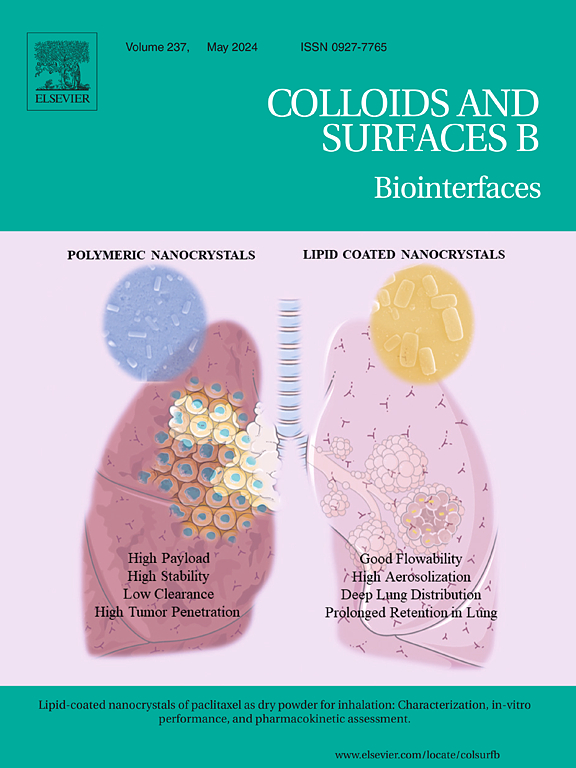Probiotics-embedded polymer films for oral health: Development, characterization, and therapeutic potential
IF 5.4
2区 医学
Q1 BIOPHYSICS
引用次数: 0
Abstract
The oral microbiome plays a crucial role in maintaining homeostasis, and microbial imbalances contribute to diseases such as periodontitis. Probiotic strains such as Lactobacillus rhamnosus and Lactobacillus reuteri have shown potential in restoring microbial balance in the oral cavity. However, their application remains challenging due to limited survival and adherence under intraoral conditions. Thus, we aimed to develop and evaluate mucoadhesive polymer films for local probiotic delivery. L. rhamnosus and L. reuteri were microencapsulated via spray drying and embedded in films composed of hydroxypropyl methylcellulose-polyvinyl alcohol (HPMC–PVA) and foamed polyvinyl alcohol (PVA). The films were characterized in terms of bacterial viability, tensile strength, folding endurance, and mucoadhesive properties. A proof-of-concept in vivo study was conducted by intraorally exposing enamel samples to two volunteers for eight hours, followed by confocal imaging and morphological analysis of adherent bacteria. Microencapsulation preserved high bacterial viability. The resulting films exhibited suitable mechanical properties and strong mucoadhesion. Biological evaluation revealed clear effects: films containing microencapsulated bacteria led to a statistically significant increase in adherent rod-shaped lactobacilli and a consistent reduction in coccoid bacteria associated with dysbiosis. The foamed PVA formulation showed the most pronounced modulation of the enamel-associated microbiota. These findings demonstrate that probiotic films can enable both bacterial stabilization and effective oral delivery. The system enhances colonization by beneficial bacteria while reducing potentially pathogenic cocci. This approach presents a promising strategy for microbiome-based prevention of oral diseases and merits further clinical investigation.
用于口腔健康的益生菌聚合物薄膜:发展、表征和治疗潜力
口腔微生物组在维持体内平衡中起着至关重要的作用,而微生物失衡会导致牙周炎等疾病。益生菌菌株如鼠李糖乳杆菌和罗伊氏乳杆菌已经显示出恢复口腔微生物平衡的潜力。然而,由于口服条件下的生存和依从性有限,它们的应用仍然具有挑战性。因此,我们的目标是开发和评估用于局部益生菌输送的黏附聚合物薄膜。采用喷雾干燥方法对鼠李糖乳杆菌和罗伊氏乳杆菌进行微囊化,包埋于羟丙基甲基纤维素-聚乙烯醇(HPMC-PVA)和泡沫聚乙烯醇(PVA)复合膜中。这些膜在细菌活力、拉伸强度、折叠耐力和粘接性能方面进行了表征。一项概念验证的体内研究是通过将牙釉质样品口内暴露给两名志愿者8小时,然后进行共聚焦成像和附着细菌的形态学分析。微胶囊化保存了较高的细菌活力。所得膜具有良好的力学性能和较强的黏附性。生物学评价显示了明显的效果:含有微囊化细菌的薄膜导致附着的杆状乳酸菌数量显著增加,与生态失调相关的球虫细菌数量持续减少。泡沫PVA配方显示出最明显的釉质相关微生物群的调节。这些发现表明,益生菌膜既可以稳定细菌,又可以有效地口服给药。该系统增强了有益细菌的定植,同时减少了潜在的致病性球菌。该方法为基于微生物群的口腔疾病预防提供了一种有前途的策略,值得进一步的临床研究。
本文章由计算机程序翻译,如有差异,请以英文原文为准。
求助全文
约1分钟内获得全文
求助全文
来源期刊

Colloids and Surfaces B: Biointerfaces
生物-材料科学:生物材料
CiteScore
11.10
自引率
3.40%
发文量
730
审稿时长
42 days
期刊介绍:
Colloids and Surfaces B: Biointerfaces is an international journal devoted to fundamental and applied research on colloid and interfacial phenomena in relation to systems of biological origin, having particular relevance to the medical, pharmaceutical, biotechnological, food and cosmetic fields.
Submissions that: (1) deal solely with biological phenomena and do not describe the physico-chemical or colloid-chemical background and/or mechanism of the phenomena, and (2) deal solely with colloid/interfacial phenomena and do not have appropriate biological content or relevance, are outside the scope of the journal and will not be considered for publication.
The journal publishes regular research papers, reviews, short communications and invited perspective articles, called BioInterface Perspectives. The BioInterface Perspective provide researchers the opportunity to review their own work, as well as provide insight into the work of others that inspired and influenced the author. Regular articles should have a maximum total length of 6,000 words. In addition, a (combined) maximum of 8 normal-sized figures and/or tables is allowed (so for instance 3 tables and 5 figures). For multiple-panel figures each set of two panels equates to one figure. Short communications should not exceed half of the above. It is required to give on the article cover page a short statistical summary of the article listing the total number of words and tables/figures.
 求助内容:
求助内容: 应助结果提醒方式:
应助结果提醒方式:


